Numerical Modeling of Ozone Loss in the Exceptional Arctic Stratosphere Winter–Spring of 2020
Abstract
:1. Introduction
- -
- Calculations with the chemistry transport model with Dynamic parameters specified from the MERRA-2 reanalysis data, carried out according to several scenarios of accounting for the chemical destruction of ozone, and
- -
- Dynamic processes contributed to the onset of the minor SSW event in late March 2020.
2. Materials and Methods
3. Results
3.1. Main Features of Arctic Stratosphere Winter 2019–2020
3.2. Ozone Loss over Selected Ozonometric Stations Using Chemistry-Transport Modeling
4. Discussion
5. Conclusions
- The enhancement of wave activity propagation over the Gulf of Alaska in the middle of March contributed to the onset of the minor SSW event and to an increase in the Arctic stratosphere temperature.
- The results of numerical calculations using CTM with Dynamic parameters specified from the MERRA-2 reanalysis data, carried out according to several scenarios of accounting for the chemical destruction of ozone, demonstrated that both Dynamic and chemical processes make a significant contribution to ozone changes over ozonometric stations, both in the Eastern and in the Western Hemispheres. Heterogeneous activation of halogen gases on the surface of polar stratospheric clouds, on the one hand, leads to a sharp increase in the destruction of ozone in chlorine and bromine catalytic cycles, and, on the other hand, decreases its destruction in nitrogen catalytic cycles.
Author Contributions
Funding
Data Availability Statement
Acknowledgments
Conflicts of Interest
References
- Tegtmeier, S.; Rex, M.; Wohltmann, I.; Kruger, K. Relative importance of dynamical and chemical contributions to Arctic wintertime ozone. Geophys. Res. Lett. 2008, 35, L17801. [Google Scholar] [CrossRef] [Green Version]
- Kidston, J.; Scaife, A.A.; Hardiman, S.C.; Mitchell, D.; Butchart, N.; Baldwin, M.P.; Gray, L. Stratospheric influence on tropospheric jet streams, storm tracks and surface weather. Nat. Geosci. 2015, 8, 433–440. [Google Scholar] [CrossRef]
- Nath, D.; Chen, W.; Zelin, C.; Pogoreltsev, A.I.; Wei, K. Dynamics of 2013 Sudden Stratospheric Warming event and its impact on cold weather over Eurasia: Role of planetary wave reflection. Sci. Rep. 2016, 6, 24174. [Google Scholar] [CrossRef]
- Peters, D.H.; Schneidereit, A.; Karpechko, A.Y. Enhanced Stratosphere/Troposphere Coupling During Extreme Warm Stratospheric Events with Strong Polar-Night Jet Oscillation. Atmosphere 2018, 9, 467. [Google Scholar] [CrossRef] [Green Version]
- King, A.D.; Butler, A.H.; Jucker, M.; Earl, N.O.; Rudeva, I. Observed Relationships Between Sudden Stratospheric Warmings and European Climate Extremes. J. Geophys. Res. Atmos. 2019, 124, 13943–13961. [Google Scholar] [CrossRef]
- Matthias, V.; Kretschmer, M. The Influence of Stratospheric Wave Reflection on North American Cold Spells. Mon. Weather. Rev. 2020, 148, 1675–1690. [Google Scholar] [CrossRef]
- Funke, B.; Ball, W.; Bender, S.; Gardini, A.; Harvey, V.L.; Lambert, A.; López-Puertas, M.; Marsh, D.R.; Meraner, K.; Nieder, H.; et al. HEPPA-II model–measurement intercomparison project: EPP indirect effects during the dynamically perturbed NH winter 2008–2009. Atmospheric Chem. Phys. Discuss. 2017, 17, 3573–3604. [Google Scholar] [CrossRef] [Green Version]
- Zülicke, C.; Becker, E.; Matthias, V.; Peters, D.H.W.; Schmidt, H.; Liu, H.-L.; Ramos, L.D.L.T.; Mitchell, D.M. Coupling of Stratospheric Warmings with Mesospheric Coolings in Observations and Simulations. J. Clim. 2018, 31, 1107–1133. [Google Scholar] [CrossRef]
- Smyshlyaev, S.P.; Pogoreltsev, A.I.; Galin, V.Y.; Drobashevskaya, E.A. Influence of wave activity on the composition of the polar stratosphere. Geomagn. Aeron. 2016, 56, 95–109. [Google Scholar] [CrossRef]
- World Meteorological Organization (WMO). Scientific Assessment of Ozone Depletion: 2018; Global Ozone Research and Monitoring Project—Report No. 58; Meteorological Organization: Geneva, Switzerland, 2018; p. 588. [Google Scholar]
- Solomon, S.; Haskins, J.; Ivy, D.J.; Min, F. Fundamental differences between Arctic and Antarctic ozone depletion. Proc. Natl. Acad. Sci. USA 2014, 111, 6220–6225. [Google Scholar] [CrossRef] [PubMed] [Green Version]
- Rex, M.; Harris, N.R.P.; von der Gathen, P.; Lehmann, R.; Braathen, G.O.; Reimer, E.; Beck, A.; Chipperfield, M.; Alfier, R.; Allaart, M.; et al. Prolonged stratospheric ozone loss in the 1995–96 Arctic winter. Nat. Cell Biol. 1997, 389, 835–838. [Google Scholar] [CrossRef]
- Lefèvre, F.; Figarol, F.; Carslaw, K.S.; Peter, T. The 1997 Arctic Ozone depletion quantified from three-dimensional model simulations. Geophys. Res. Lett. 1998, 25, 2425–2428. [Google Scholar] [CrossRef]
- Rex, M.; Salawitch, R.J.; Harris, N.R.P.; von der Gathen, P.; Braathen, G.O.; Schulz, A.; Deckelmann, H.; Chipperfield, M.; Sinnhuber, B.-M.; Reimer, E.; et al. Chemical depletion of Arctic ozone in winter 1999/2000. J. Geophys. Res. Space Phys. 2002, 107, SOL-18. [Google Scholar] [CrossRef] [Green Version]
- Manney, G.L.; Santee, M.L.; Froidevaux, L.; Hoppel, K.; Livesey, N.J.; Waters, J.W. EOS MLS observations of ozone loss in the 2004–2005 Arctic winter. Geophys. Res. Lett. 2006, 33. [Google Scholar] [CrossRef] [Green Version]
- Manney, G.L.; Santee, M.L.; Rex, M.; Livesey, N.J.; Pitts, M.C.; Veefkind, P.; Nash, E.R.; Wohltmann, I.; Lehmann, R.; Froidevaux, L.; et al. Unprecedented Arctic ozone loss in 2011. Nat. Cell Biol. 2011, 478, 469–475. [Google Scholar] [CrossRef] [PubMed]
- World Meteorological Organization (WMO). Scientific Assessment of Ozone Depletion: 2014; Global Ozone Research and Monitoring Project—Report No. 55; Meteorological Organization: Geneva, Switzerland, 2014; p. 416. [Google Scholar]
- Manney, G.L.; Lawrence, Z.D. The major stratospheric final warming in 2016: Dispersal of vortex air and termination of Arctic chemical ozone loss. Atmospheric Chem. Phys. Discuss. 2016, 16, 15371–15396. [Google Scholar] [CrossRef] [Green Version]
- Khosrawi, F.; Kirner, O.; Sinnhuber, B.-M.; Johansson, S.; Höpfner, M.; Santee, M.L.; Froidevaux, L.; Ungermann, J.; Ruhnke, R.; Woiwode, W.; et al. Denitrification, dehydration and ozone loss during the 2015/2016 Arctic winter. Atmospheric Chem. Phys. Discuss. 2017, 17, 12893–12910. [Google Scholar] [CrossRef] [Green Version]
- Nikiforova, M.P.; Vargin, P.N.; Zvyagintsev, A.M. Ozone Anomalies over Russia in the Winter-Spring of 2015/2016. Russ. Meteorol. Hydrol. 2019, 44, 23–32. [Google Scholar] [CrossRef]
- Timofeyev, Y.M.; Smyshlyaev, S.P.; Virolainen, Y.A.; Garkusha, A.S.; Polyakov, A.V.; Motsakov, M.A.; Kirner, O. Case study of ozone anomalies over northern Russia in the 2015/2016 winter: Measurements and numerical modelling. Ann. Geophys. 2018, 36, 1495–1505. [Google Scholar] [CrossRef] [Green Version]
- Lawrence, Z.D.; Perlwitz, J.; Butler, A.H.; Manney, G.L.; Newman, P.A.; Lee, S.H.; Nash, E.R. The Remarkably Strong Arctic Stratospheric Polar Vortex of Winter 2020: Links to Record-Breaking Arctic Oscillation and Ozone Loss. J. Geophys. Res. Atmos. 2020, 125, 125. [Google Scholar] [CrossRef]
- Manney, G.L.; Livesey, N.J.; Santee, M.L.; Froidevaux, L.; Lambert, A.; Lawrence, Z.D.; Millán, L.F.; Neu, J.L.; Read, W.G.; Schwartz, M.J.; et al. Record-Low Arctic Stratospheric Ozone in 2020: MLS Observations of Chemical Processes and Comparisons with Previous Extreme Winters. Geophys. Res. Lett. 2020, 47, 47. [Google Scholar] [CrossRef]
- Grooß, J.U.; Müller, R. Simulation of record Arctic stratospheric ozone depletion in 2020. J. Geophys. Res. Atmos. 2021, 126, e2020JD033339. [Google Scholar] [CrossRef]
- Wohltmann, I.; von der Gathen, P.; Lehmann, R.; Maturilli, M.; Deckelmann, H.; Manney, G.L.; Davies, J.; Tarasick, D.; Jepsen, N.; Kivi, R.; et al. Near-Complete Local Reduction of Arctic Stratospheric Ozone by Severe Chemical Loss in Spring 2020. Geophys. Res. Lett. 2020, 47, e2020GL089547. [Google Scholar] [CrossRef]
- Dameris, M.; Loyola, D.G.; Nützel, M.; Coldewey-Egbers, M.; Lerot, C.; Romahn, F.; van Roozendael, M. Record low ozone values over the Arctic in boreal spring 2020. Atmospheric Chem. Phys. Discuss. 2021, 21, 617–633. [Google Scholar] [CrossRef]
- Wohltmann, I.; von der Gathen, P.; Lehmann, R.; Deckelmann, H.; Manney, G.L.; Davies, J.; Tarasick, D.; Jepsen, N.; Kivi, R.; Lyall, N.; et al. Chemical evolution of the exceptional Arctic stratospheric winter 2019/2020 compared to previous Arctic and Antarctic winters. J. Geophys. Res. Atmos. 2021, 126, e2020JD034356. [Google Scholar] [CrossRef]
- Waters, J.W.; Froidevaux, L.; Harwood, R.S.; Jarnot, R.F.; Pickett, H.M.; Read, W.G.; Siegel, P.H.; Cofield, R.E.; Filipiak, M.J.; Flower, D.A.; et al. The Earth observing system microwave limb sounder (EOS MLS) on the aura Satellite. IEEE Trans. Geosci. Remote. Sens. 2006, 44, 1075–1092. [Google Scholar] [CrossRef]
- Inness, A.; Chabrillat, S.; Flemming, J.; Huijnen, V.; Langenrock, B.; Nicolas, J.; Polichtchouk, I.; Razinger, M. Exceptionally Low Arctic Stratospheric Ozone in Spring 2020 as Seen in the CAMS Reanalysis. J. Geophys. Res. Atmos. 2020, 125, e2020JD033563. [Google Scholar] [CrossRef]
- Bernhard, G.H.; Fioletov, V.E.; Grooß, J.-U.; Ialongo, I.; Johnsen, B.; Lakkala, K.; Manney, G.L.; Müller, R.; Svendby, T. Record-Breaking Increases in Arctic Solar Ultraviolet Radiation Caused by Exceptionally Large Ozone Depletion in 2020. Geophys. Res. Lett. 2020, 47, e2020GL090844. [Google Scholar] [CrossRef]
- DeLand, M.T.; Bhartia, P.K.; Kramarova, N.; Chen, Z. OMPS LP Observations of PSC Variability During the NH 2019–2020 Season. Geophys. Res. Lett. 2020, 47, 2020JD090216. [Google Scholar] [CrossRef]
- Feng, W.; Dhomse, S.S.; Arosio, C.; Weber, M.; Burrows, J.P.; Santee, M.L.; Chipperfield, M.P. Arctic Ozone Depletion in 2019/20: Roles of Chemistry, Dynamics and the Montreal Protocol. Geophys. Res. Lett. 2021, 48, e2020GL091911. [Google Scholar] [CrossRef]
- Hardiman, S.C.; Dunstone, N.J.; Scaife, A.A.; Smith, D.M.; Knight, J.R.; Davies, P.; Claus, M.; Greatbatch, R.J. Predictability of European winter 2019/20: Indian Ocean dipole impacts on the NAO. Atmospheric Sci. Lett. 2020, 21, e1005. [Google Scholar] [CrossRef]
- Domeisen, D.I.V.; Garfinkel, C.I.; Butler, A.H. The Teleconnection of El Niño Southern Oscillation to the Stratosphere. Rev. Geophys. 2019, 57, 5–47. [Google Scholar] [CrossRef] [Green Version]
- Abram, N.J.; Wright, N.M.; Ellis, B.; Dixon, B.C.; Wurtzel, J.B.; England, M.H.; Ummenhofer, C.C.; Philibosian, B.; Cahyarini, S.Y.; Yu, T.-L.; et al. Coupling of Indo-Pacific climate variability over the last millennium. Nat. Cell Biol. 2020, 579, 385–392. [Google Scholar] [CrossRef]
- Langematz, U.; Meul, S.; Grunow, K.; Romanowsky, E.; Oberländer, S.; Abalichin, J.; Kubin, A. Future Arctic temperature and ozone: The role of stratospheric composition changes. J. Geophys. Res. Atmos. 2014, 119, 2092–2112. [Google Scholar] [CrossRef]
- Rex, M.; Salawitch, R.J.; von der Gathen, P.; Harris, N.R.P.; Chipperfield, M.; Naujokat, B. Arctic ozone loss and climate change. Geophys. Res. Lett. 2004, 31. [Google Scholar] [CrossRef]
- Von der Gathen, P.; Kivi, R.; Wohltmann, I.; Salawitch, R.J.; Rex, M. Climate change favours large seasonal loss of Arctic ozone. Nat. Commun. 2021, 12, 1–17. [Google Scholar] [CrossRef]
- Pommereau, J.-P.; Goutail, F.; Pazmino, A.; Lefèvre, F.; Chipperfield, M.P.; Feng, W.; van Roozendael, M.; Jepsen, N.; Hansen, G.; Kivi, R.; et al. Recent Arctic ozone depletion: Is there an impact of climate change? Comptes Rendus Geosci. 2018, 350, 347–353. [Google Scholar] [CrossRef]
- Eleftheratos, K.; Kapsomenakis, J.; Zerefos, C.S.; Bais, A.F.; Fountoulakis, I.; Dameris, S.; Jöckel, P.; Haslerud, A.S.; Godin-Beekmann, S.; Steinbrecht, W.; et al. Possible Effects of Greenhouse Gases to Ozone Profiles and DNA Active UV-B Irradiance at Ground Level. Atmosphere 2020, 11, 228. [Google Scholar] [CrossRef] [Green Version]
- Newman, P.A.; Oman, L.D.; Douglass, A.R.; Fleming, E.L.; Frith, S.M.; Hurwitz, M.M.; Kawa, S.R.; Jackman, C.H.; Krotkov, N.A.; Nash, E.R.; et al. What would have happened to the ozone layer if chlorofluorocarbons (CFCs) had not been regulated? Atmospheric Chem. Phys. Discuss. 2009, 9, 2113–2128. [Google Scholar] [CrossRef] [Green Version]
- Weber, M.; Coldewey-Egbers, M.; Fioletov, V.E.; Frith, S.M.; Wild, J.D.; Burrows, J.P.; Long, C.S.; Loyola, D. Total ozone trends from 1979 to 2016 derived from five merged observational datasets—The emergence into ozone recovery. Atmos. Chem. Phys. Discuss. 2018, 18, 2097–2117. [Google Scholar] [CrossRef] [Green Version]
- Zerefos, C.; Kapsomenakis, J.; Eleftheratos, K.; Tourpali, K.; Petropavlovskikh, I.; Hubert, D.; Godin-Beekmann, S.; Steinbrecht, W.; Frith, S.; Sofieva, V.; et al. Representativeness of single lidar stations for zonally averaged ozone profiles, their trends and attribution to proxies. Atmos. Chem. Phys. Discuss. 2018, 18, 6427–6440. [Google Scholar] [CrossRef] [Green Version]
- Smyshlyaev, S.P.; Virolainen, Y.A.; Timofeev, Y.M.; Poberovsky, A.V.; Polyakov, A.V. Interannual and seasonal ozone variability in the several altitude regions near Saint-Petersburg based on the observations and numerical modeling. Izv. Atmos. Ocean. Phys. 2017, 53, 301–315. [Google Scholar] [CrossRef]
- Kalnay, E.; Kanamitsu, M.; Kistler, R.; Collins, W.; Deaven, D.; Gandin, L.; Iredell, M.; Saha, S.; White, G.; Woollen, J.; et al. The NCEP/NCAR 40-year reanalysis project. Bull. Amer. Meteor. Soc. 1996, 77, 437–470. [Google Scholar] [CrossRef] [Green Version]
- Gelaro, R.; McCarty, W.; Suárez, M.J.; Todling, R.; Molod, A.; Takacs, L.; Randles, C.A.; Darmenov, A.; Bosilovich, M.G.; Reichle, R.; et al. The Modern-Era Retrospective Analysis for Research and Applications, Version 2 (MERRA-2). J. Clim. 2017, 30, 5419–5454. [Google Scholar] [CrossRef]
- Plumb, R. On the Three-Dimensional Propagation of Stationary Waves. J. Atmos. Sci. 1985, 42, 217–229. [Google Scholar] [CrossRef]
- Peters, D.H.W.; Vargin, P.; Gabriel, A.; Tsvetkova, N.; Yushkov, V. Tropospheric forcing of the boreal polar vortex splitting in January 2003. Ann. Geophys. 2010, 28, 2133–2148. [Google Scholar] [CrossRef] [Green Version]
- Runde, T.; Dameris, M.; Garny, H.; Kinnison, D.E. Classification of stratospheric extreme events according to their downward propagation to the troposphere. Geophys. Res. Lett. 2016, 43, 6665–6672. [Google Scholar] [CrossRef] [Green Version]
- Polvani, L.M.; Waugh, D.W. Upward wave activity flux as a precursor to extreme stratospheric events and subsequent anomalous surface weather regimes. J. Climate. 2004, 17, 3548–3554. [Google Scholar] [CrossRef]
- Galin, V.Y.; Smyshlyaev, S.P.; Volodin, E.M. Combined chemistry-climate model of the atmosphere. Izv. Atmospheric Ocean. Phys. 2007, 43, 399–412. [Google Scholar] [CrossRef]
- Smyshlyaev, S.P.; Galin, V.Y.; Blakitnaya, P.A.; Jakovlev, A.R. Numerical Modeling of the Natural and Manmade Factors Influencing Past and Current Changes in Polar, Mid-Latitude and Tropical Ozone. Atmosphere 2020, 11, 76. [Google Scholar] [CrossRef] [Green Version]
- Smyshlyaev, S.P.; Dvortsov, V.L.; Geller, M.A.; Yudin, V.A. A two-dimensional model with input parameters from a general circulation model: Ozone sensitivity to different formulations for the longitudinal temperature variation. J. Geophys. Res. Space Phys. 1998, 103, 28373–28387. [Google Scholar] [CrossRef]
- Carslaw, K.S.; Luo, B.; Peter, T. An analytic expression for the composition of aqueous HNO3-H2SO4 stratospheric aerosols including gas phase removal of HNO3. Geophys. Res. Lett. 1995, 22, 1877–1880. [Google Scholar] [CrossRef]
- Søvde, O.A.; Gauss, M.; Smyshlyaev, S.; Isaksen, I.S.A. Evaluation of the chemical transport model Oslo CTM2 with focus on arctic winter ozone depletion. J. Geophys. Res. Space Phys. 2008, 113. [Google Scholar] [CrossRef]
- Smyshlyaev, S.P.; Galin, V.Y.; Shaariibuu, G.; Motsakov, M.A. Modeling the variability of gas and aerosol components in the stratosphere of polar regions. Izv. Atmospheric Ocean. Phys. 2010, 46, 265–280. [Google Scholar] [CrossRef]
- IPCC. Annex II: Climate System Scenario Tables. Available online: https://www.ipcc.ch/site/assets/uploads/2017/09/WG1AR5_AnnexII_FINAL.pdf (accessed on 29 October 2021).
- Levelt, P.F.; Joiner, J.; Tamminen, J.; Veefkind, J.P.; Bhartia, P.K.; Zweers, D.C.S.; Duncan, B.N.; Streets, D.G.; Eskes, H.; van der, A.R.; et al. The Ozone Monitoring Instrument: Overview of 14 years in space. Atmos. Chem. Phys. 2018, 18, 5699–5745. [Google Scholar] [CrossRef] [Green Version]
- Labow, G.J.; McPeters, R.D.; Bhartia, P.K.; Kramarova, N. A comparison of 40 years of SBUV measurements of column ozone with data from the Dobson/Brewer network. J. Geophys. Res. Atmos. 2013, 118, 7370–7378. [Google Scholar] [CrossRef]
- Newman, P.A.; Nash, E.R.; Rosenfield, J.E. What controls the temperature of the Arctic stratosphere during the spring? J. Geophys. Res. Space Phys. 2001, 106, 19999–20010. [Google Scholar] [CrossRef] [Green Version]
- Thompson, D.W.J.; Wallace, J.M. The Arctic oscillation signature in the wintertime geopotential height and temperature fields. Geophys. Res. Lett. 1998, 25, 1297–1300. [Google Scholar] [CrossRef] [Green Version]
- Zyulyaeva, Y.A.; Zhadin, E.A. Analysis of three-dimensional Eliassen-Palm fluxes in the lower stratosphere. Russ. Meteorol. Hydrol. 2009, 34, 483–490. [Google Scholar] [CrossRef]
- Gečaitė, I. Climatology of Three-Dimensional Eliassen–Palm Wave Activity Fluxes in the Northern Hemisphere Stratosphere from 1981 to 2020. Climate 2021, 9, 124. [Google Scholar] [CrossRef]
- Wei, K.; Ma, J.; Chen, W.; Vargin, P. Longitudinal peculiarities of planetary waves-zonal flow interactions and their role in stratosphere-troposphere dynamical coupling. Clim. Dyn. 2021, 57, 2843–2862. [Google Scholar] [CrossRef]
- Coy, L.; Eckermann, S.; Hoppel, K. Planetary Wave Breaking and Tropospheric Forcing as Seen in the Stratospheric Sudden Warming of 2006. J. Atmospheric Sci. 2009, 66, 495–507. [Google Scholar] [CrossRef]
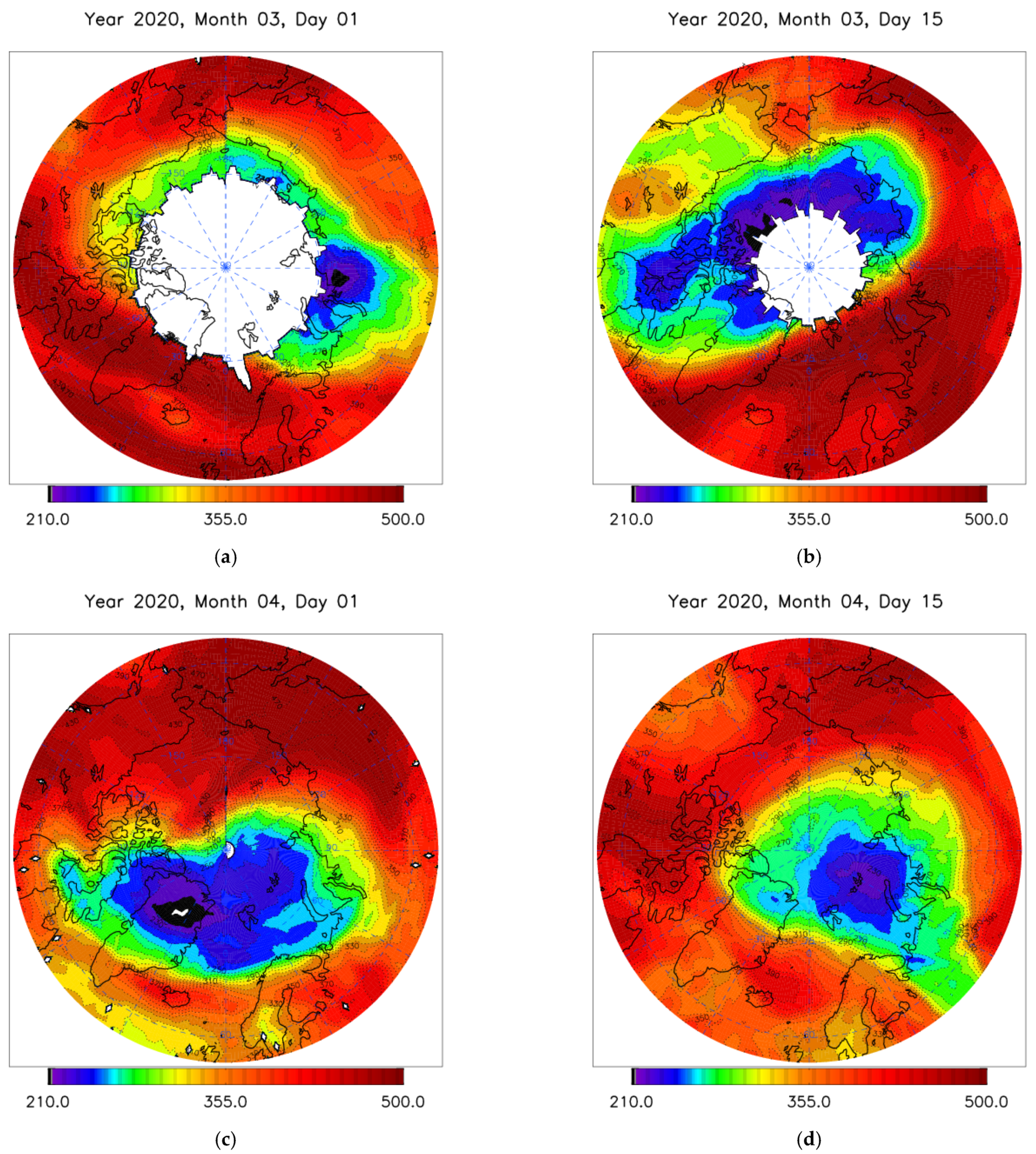
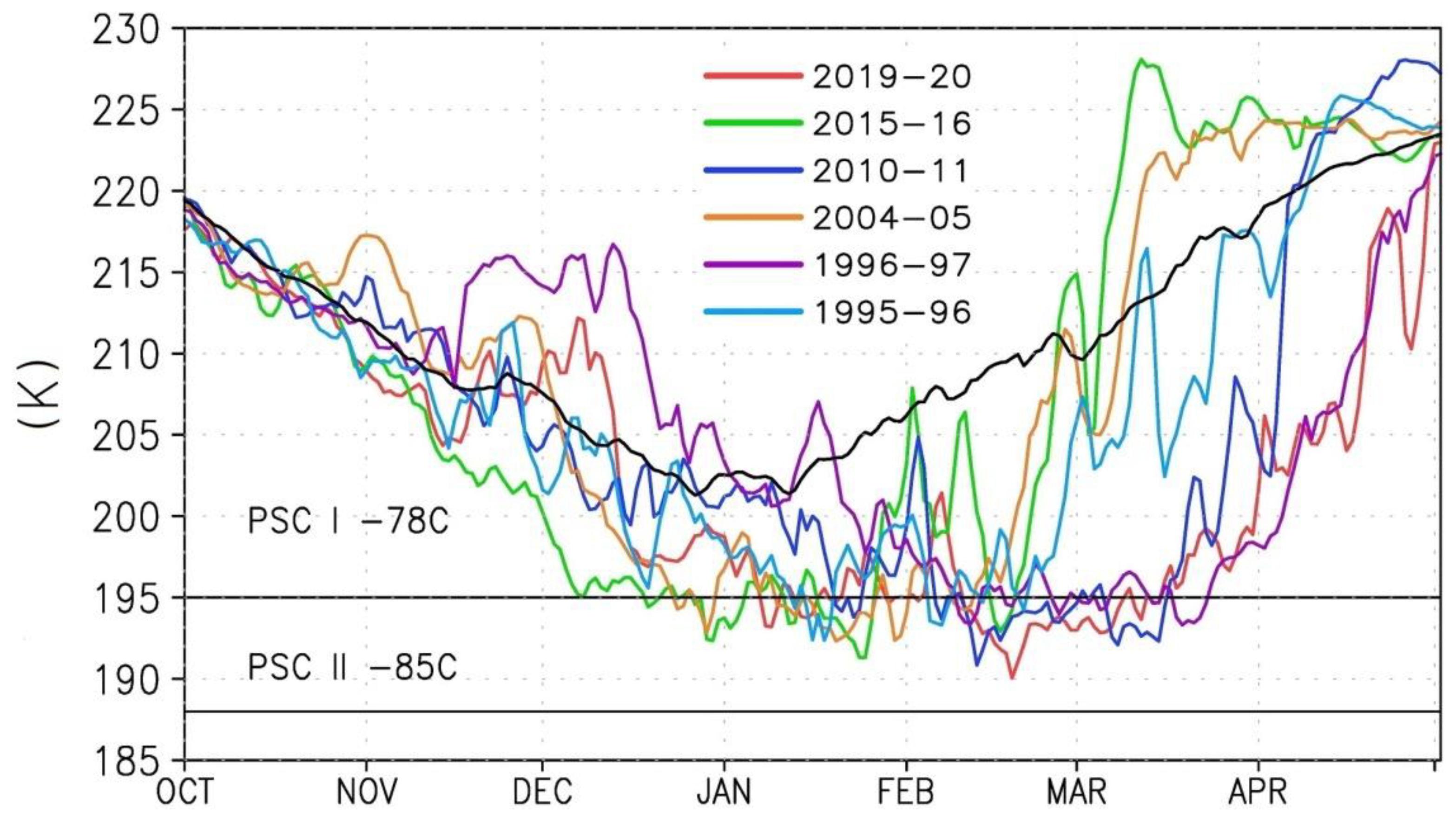

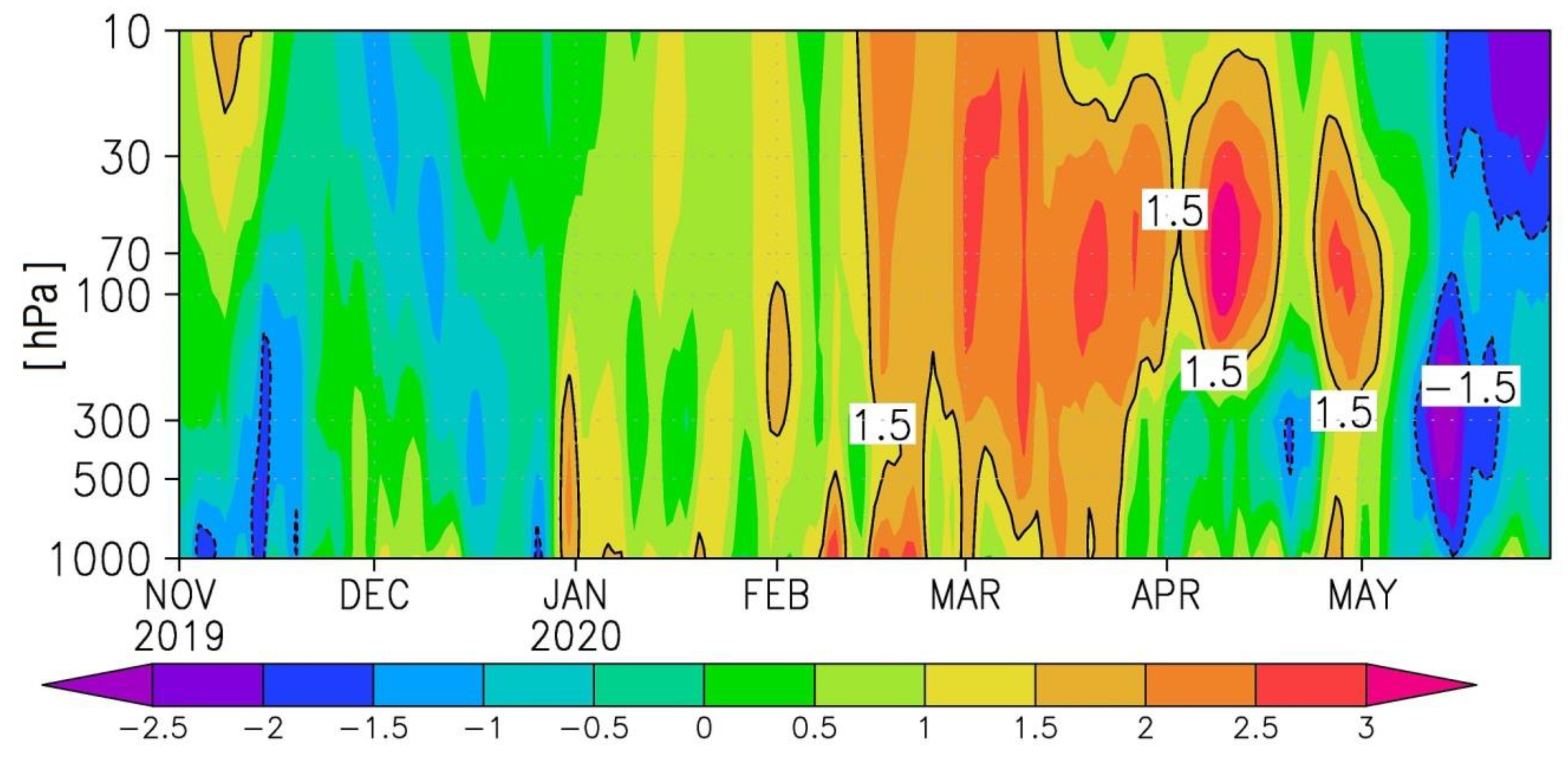
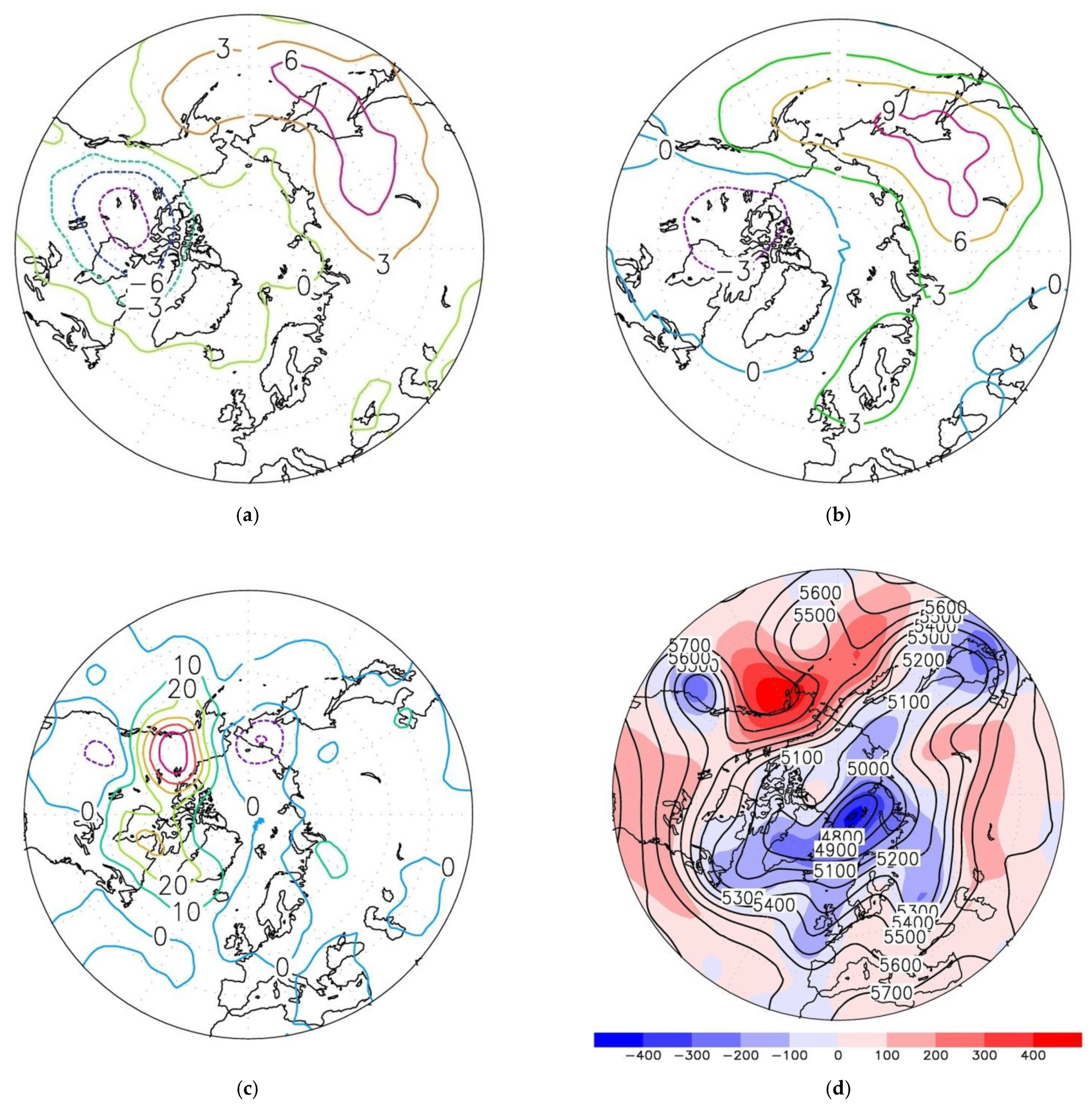
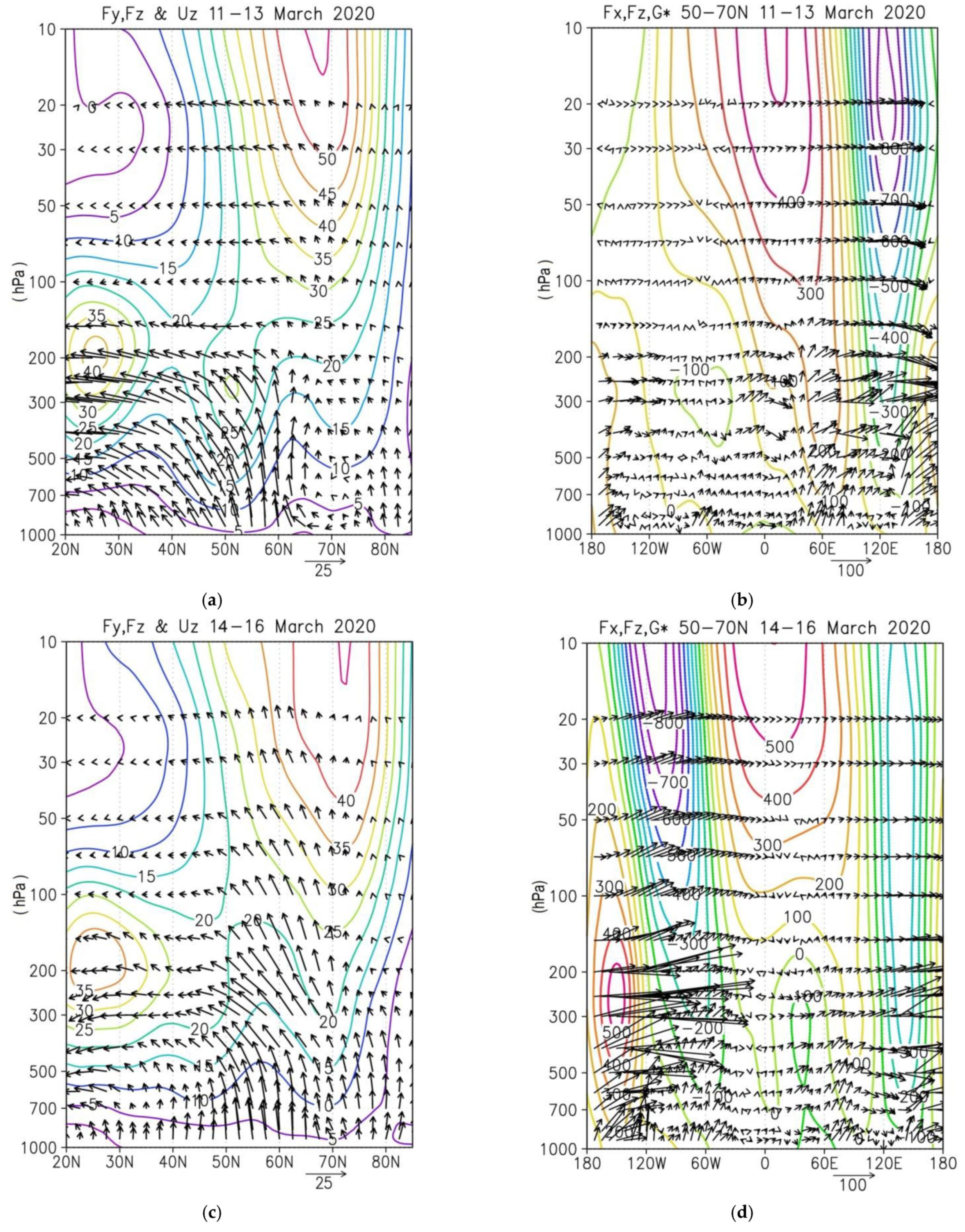

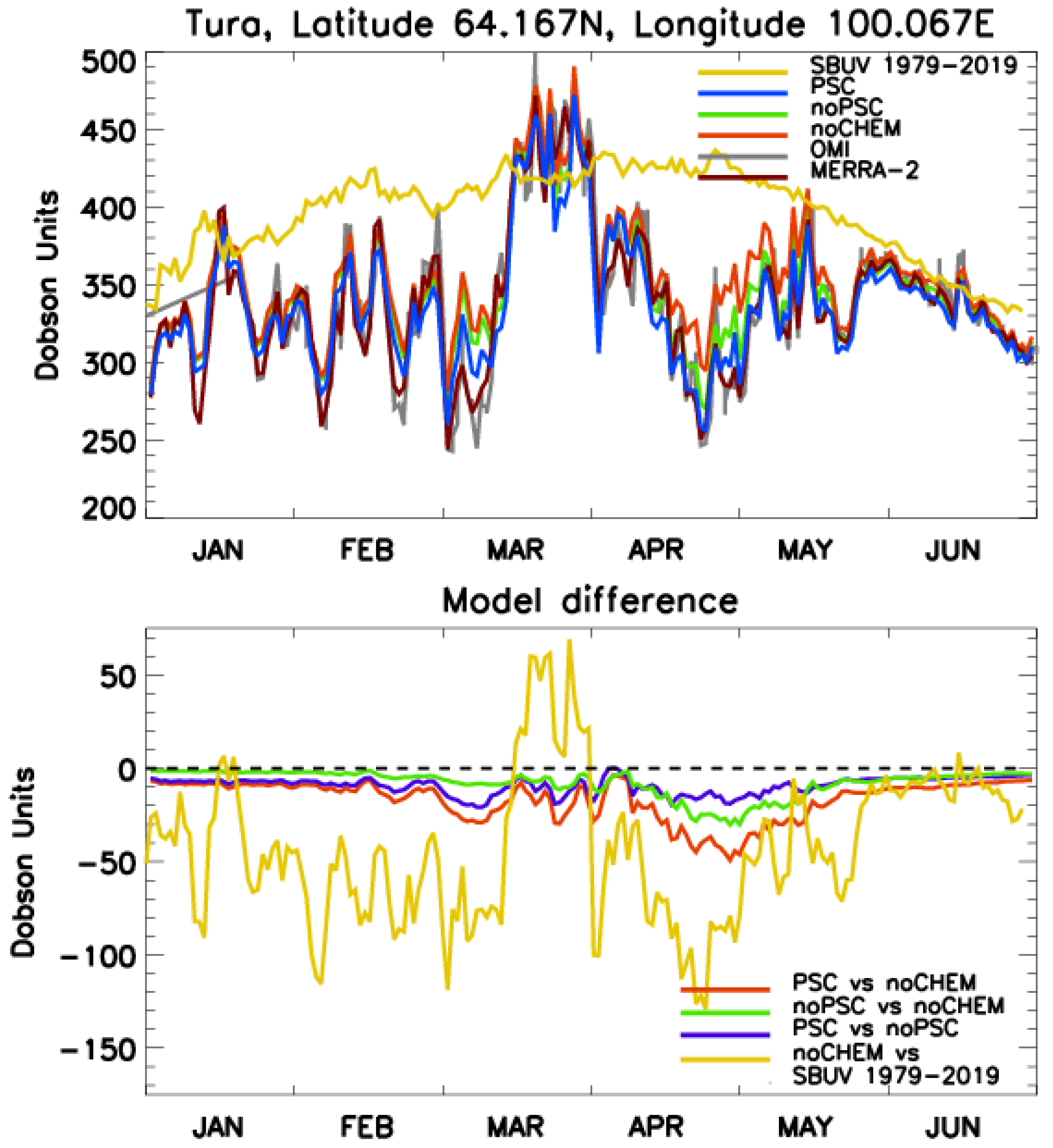
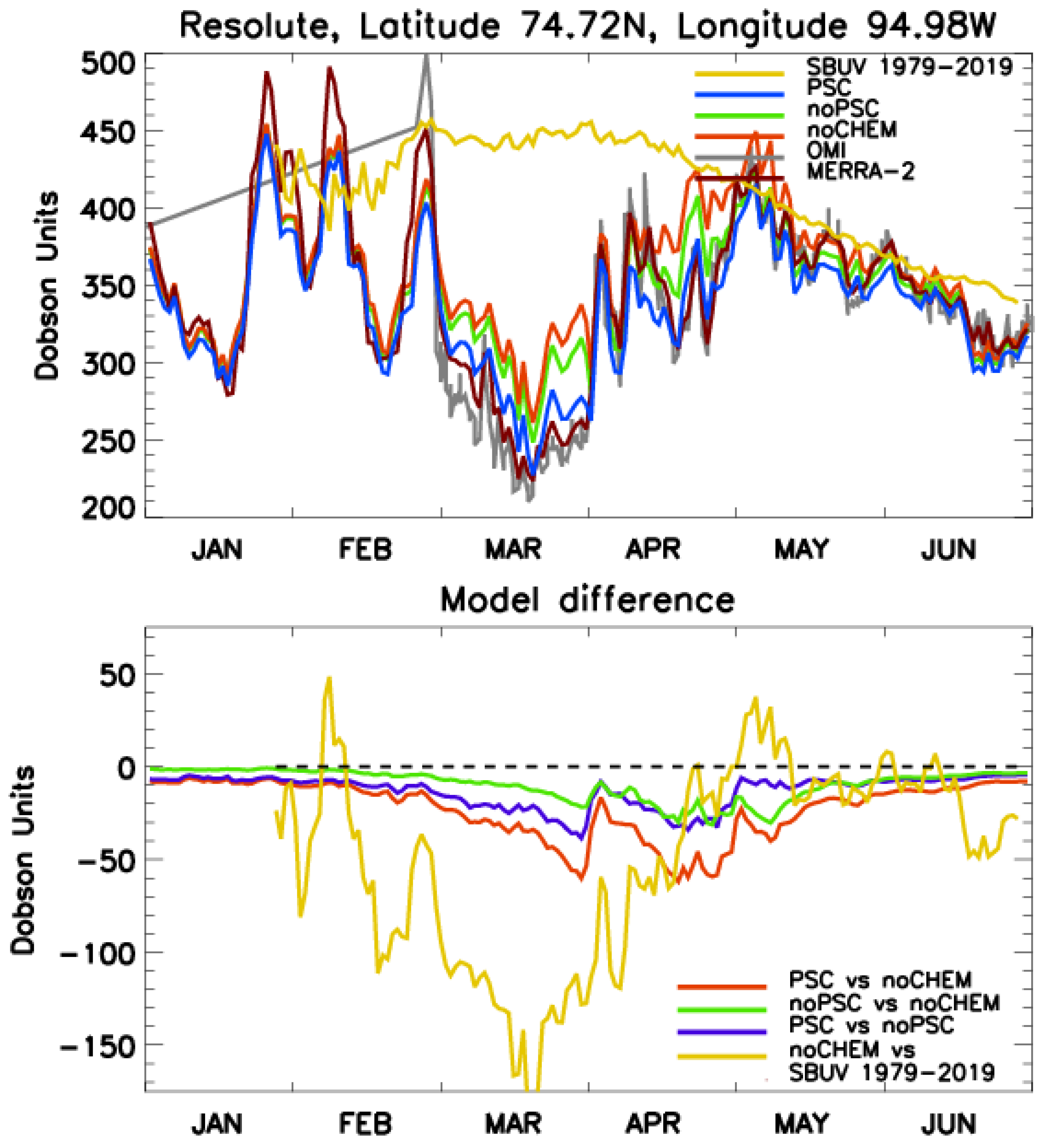
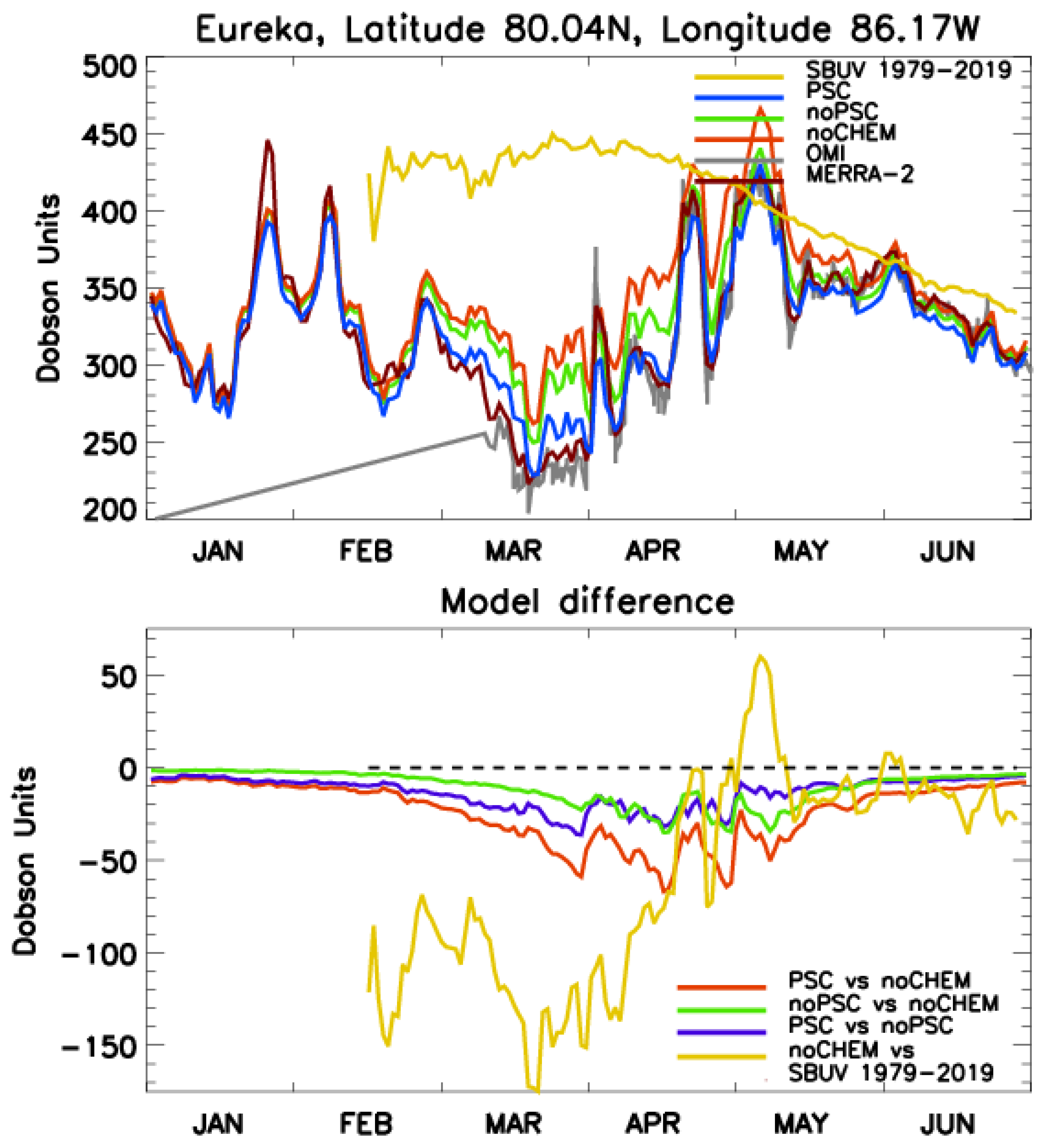
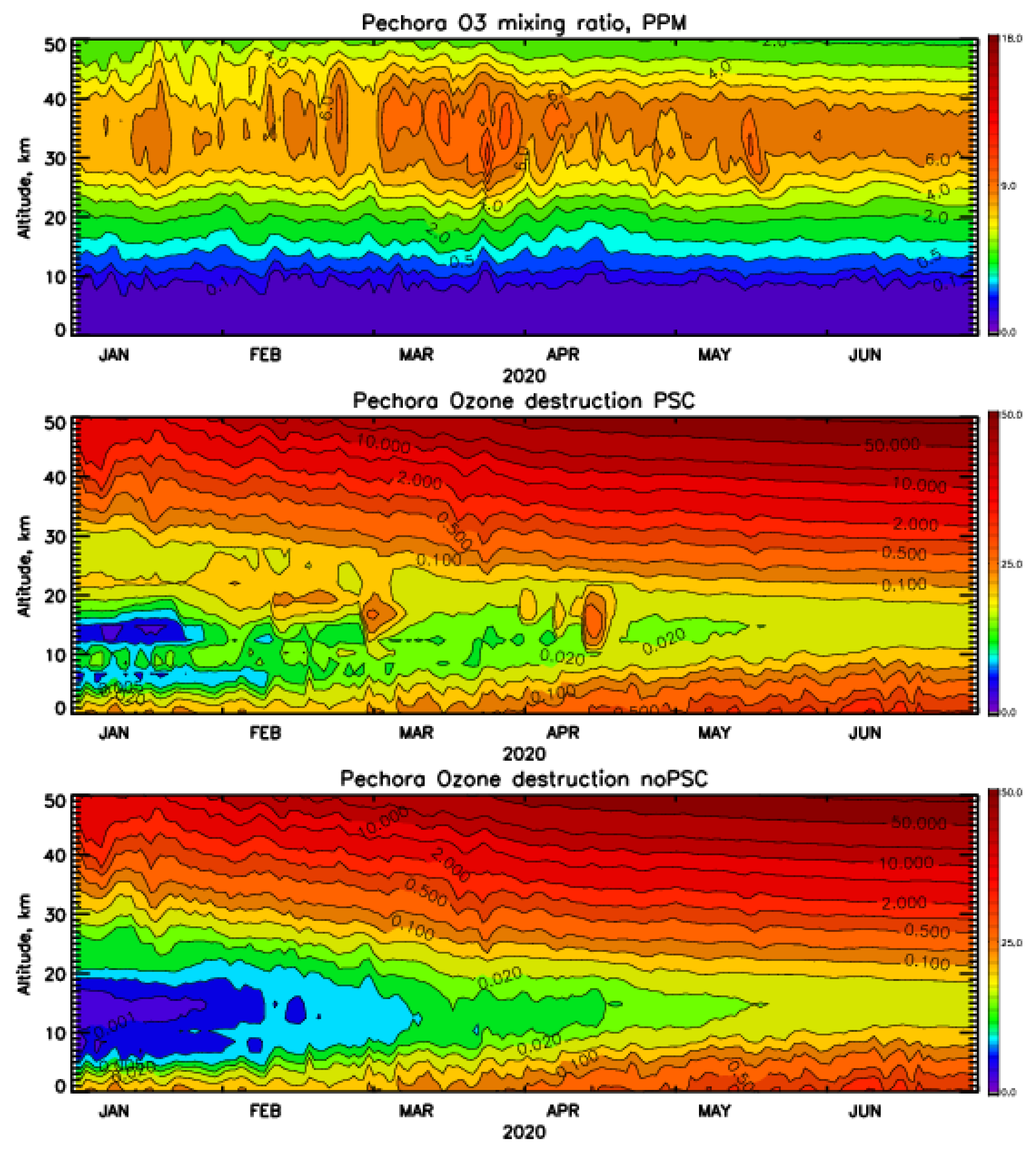
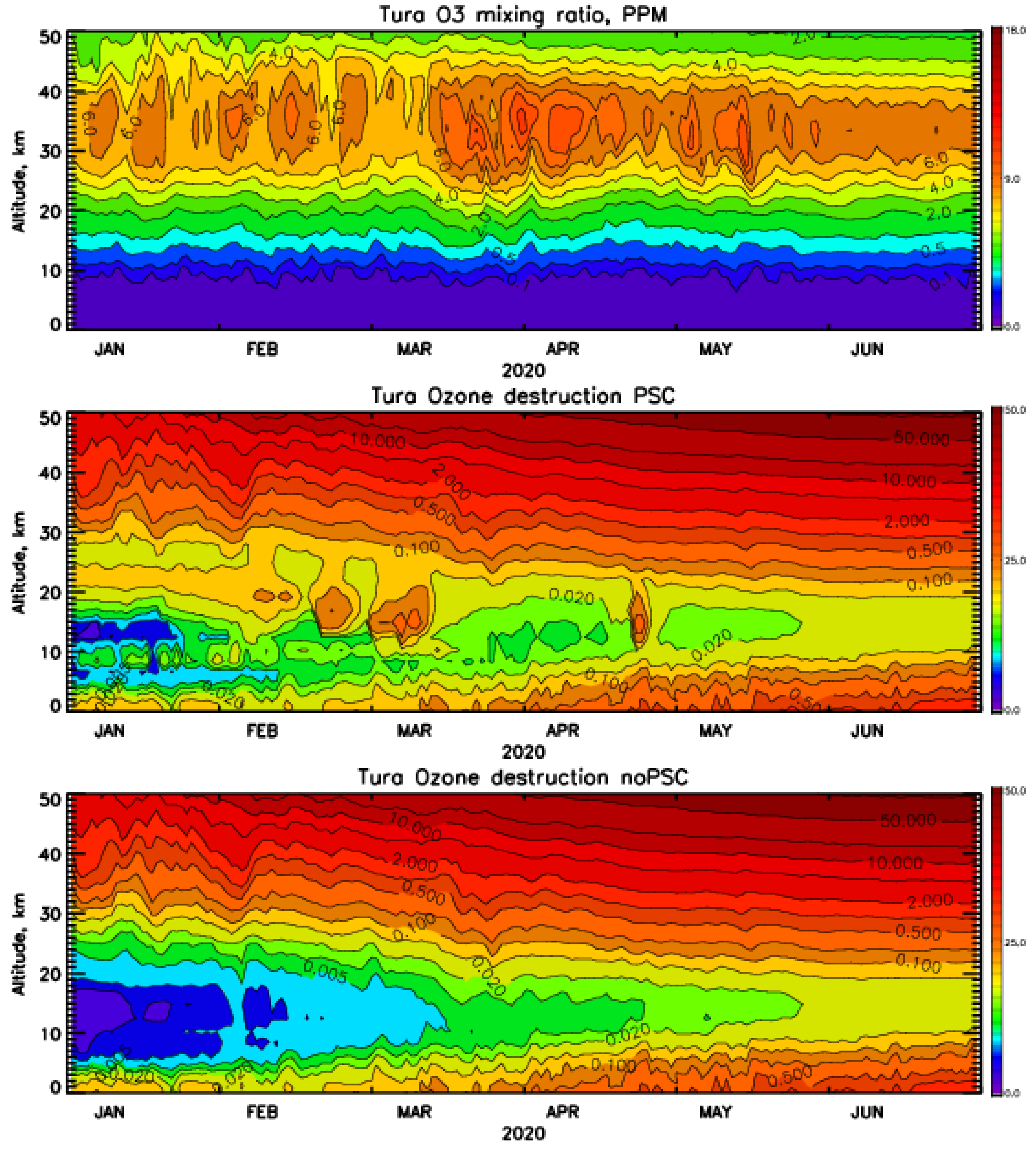
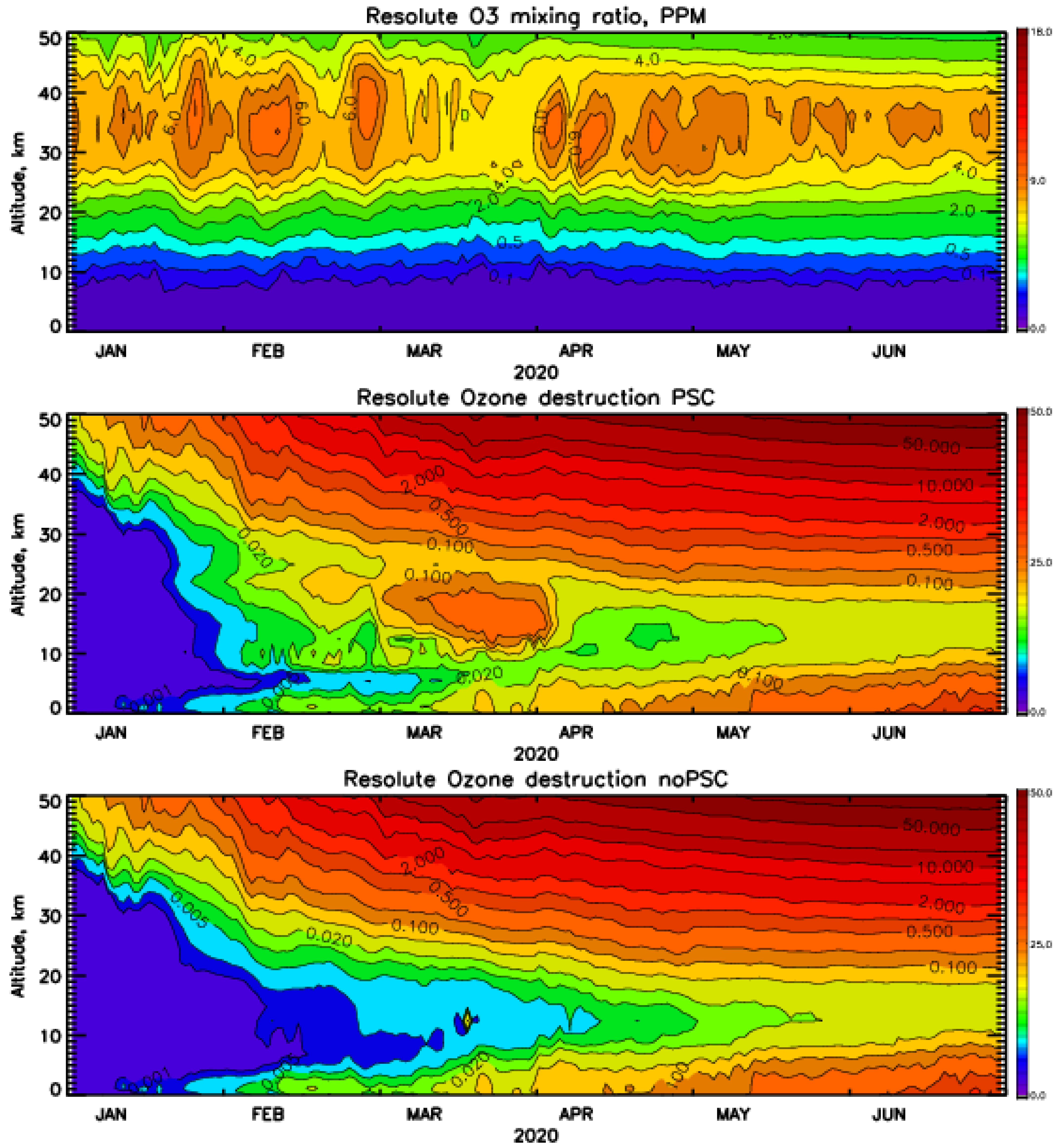
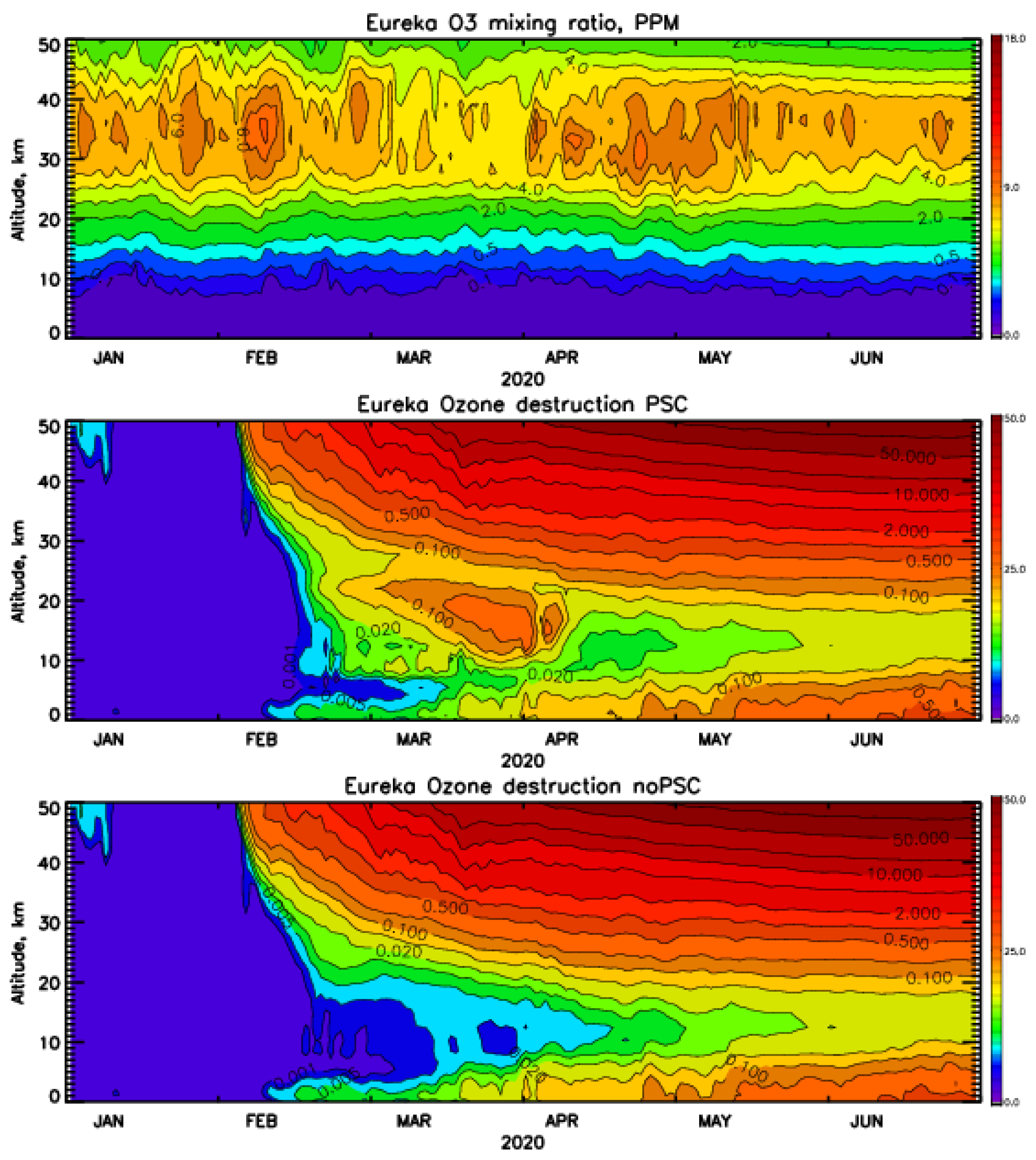
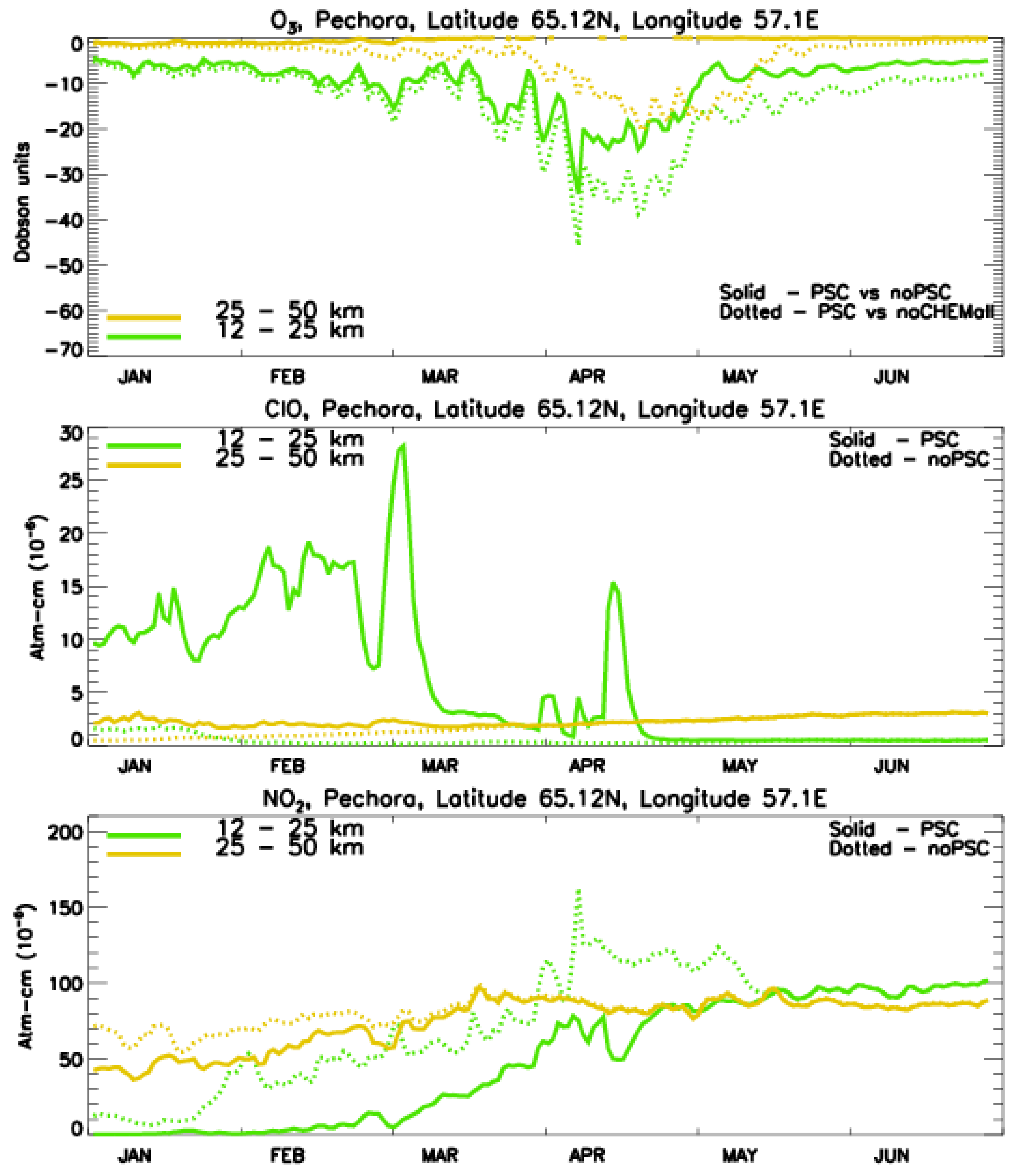
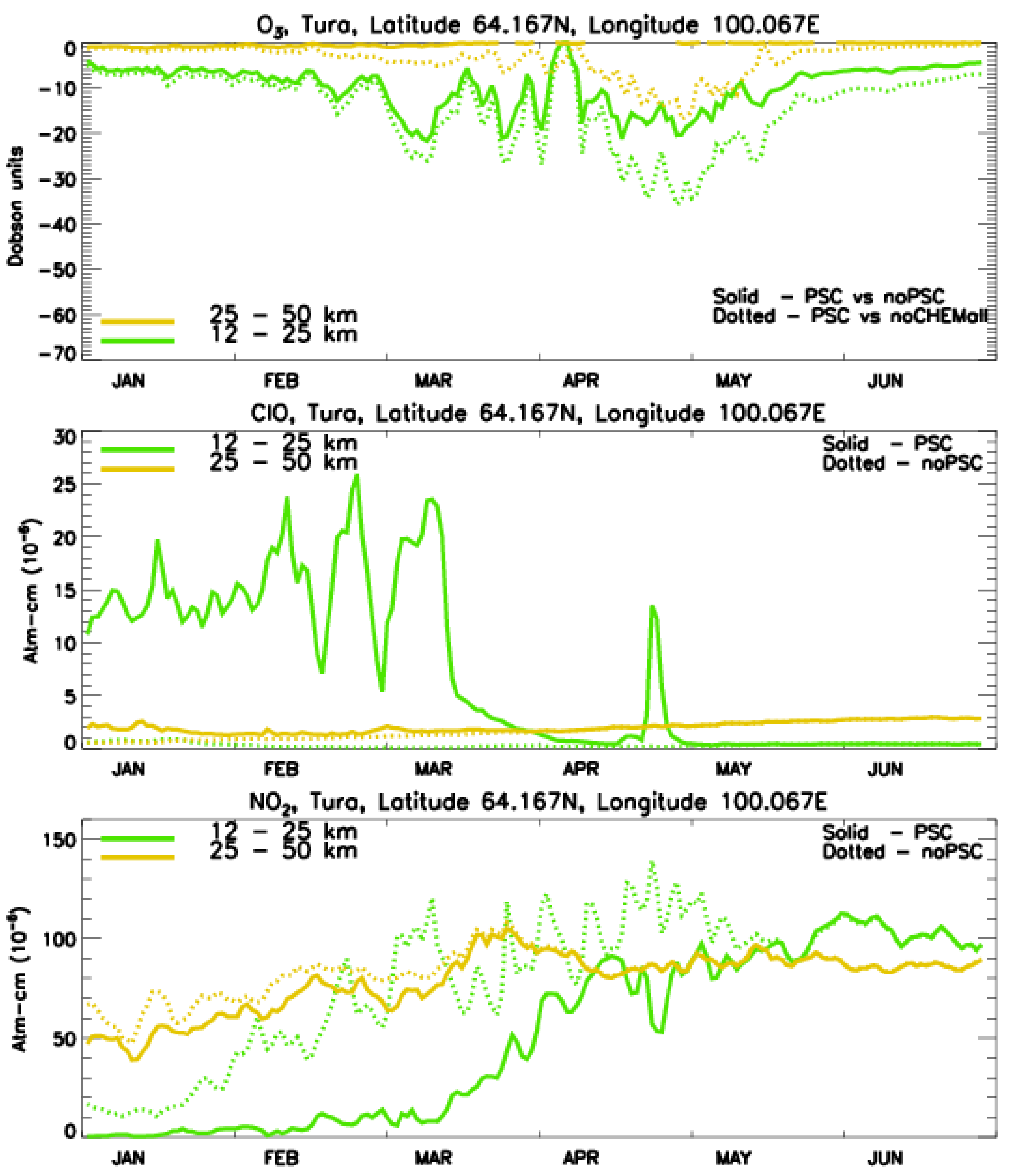
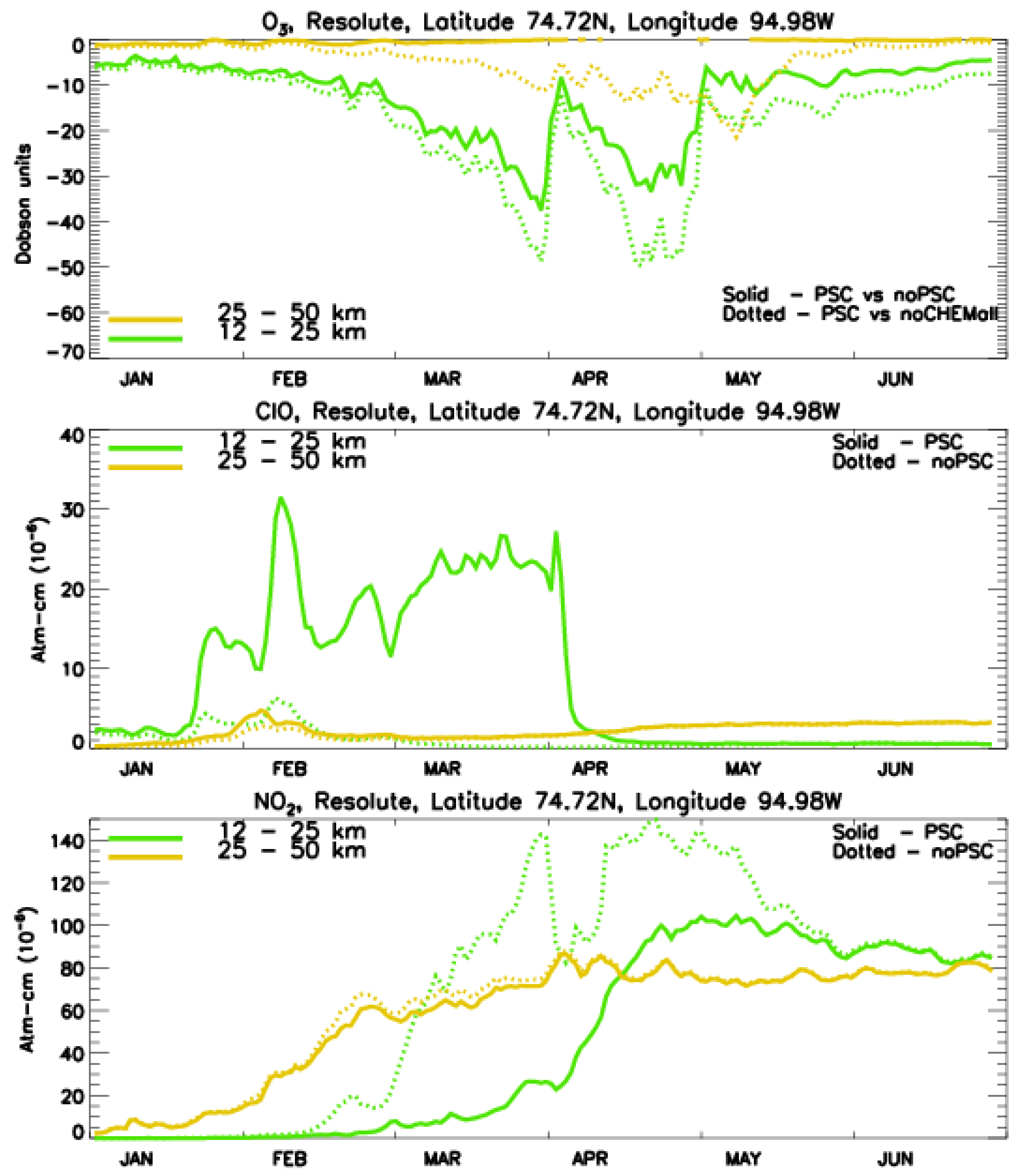
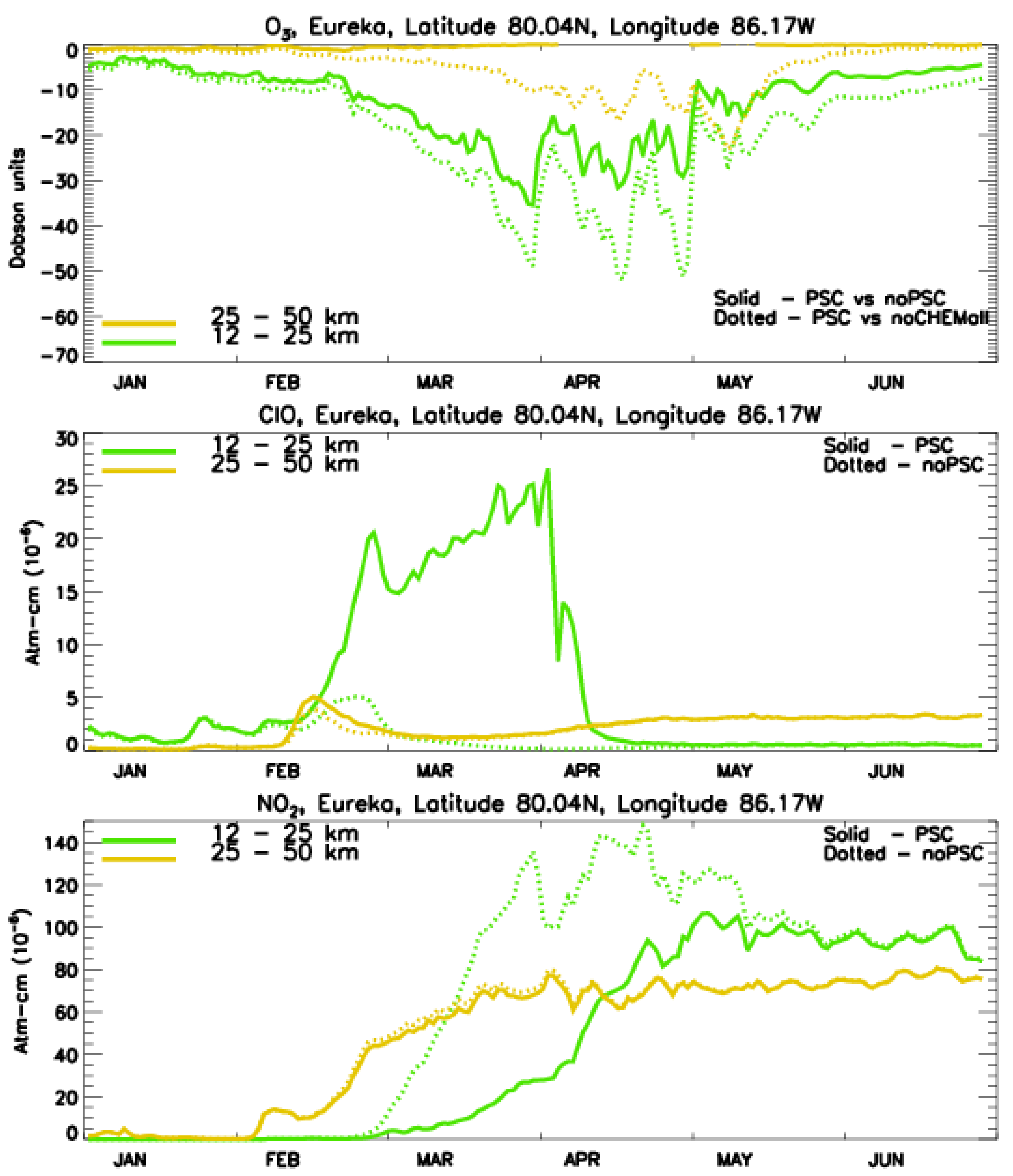
Publisher’s Note: MDPI stays neutral with regard to jurisdictional claims in published maps and institutional affiliations. |
© 2021 by the authors. Licensee MDPI, Basel, Switzerland. This article is an open access article distributed under the terms and conditions of the Creative Commons Attribution (CC BY) license (https://creativecommons.org/licenses/by/4.0/).
Share and Cite
Smyshlyaev, S.P.; Vargin, P.N.; Motsakov, M.A. Numerical Modeling of Ozone Loss in the Exceptional Arctic Stratosphere Winter–Spring of 2020. Atmosphere 2021, 12, 1470. https://doi.org/10.3390/atmos12111470
Smyshlyaev SP, Vargin PN, Motsakov MA. Numerical Modeling of Ozone Loss in the Exceptional Arctic Stratosphere Winter–Spring of 2020. Atmosphere. 2021; 12(11):1470. https://doi.org/10.3390/atmos12111470
Chicago/Turabian StyleSmyshlyaev, Sergey P., Pavel N. Vargin, and Maksim A. Motsakov. 2021. "Numerical Modeling of Ozone Loss in the Exceptional Arctic Stratosphere Winter–Spring of 2020" Atmosphere 12, no. 11: 1470. https://doi.org/10.3390/atmos12111470
APA StyleSmyshlyaev, S. P., Vargin, P. N., & Motsakov, M. A. (2021). Numerical Modeling of Ozone Loss in the Exceptional Arctic Stratosphere Winter–Spring of 2020. Atmosphere, 12(11), 1470. https://doi.org/10.3390/atmos12111470





